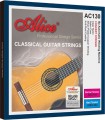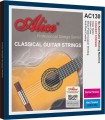The diameter of the strings in the set, from thinnest to thickest.
Thicker strings, all other things being equal, provide more volume and richness to the sound, have more overtones, and generally sound richer and warmer (high frequencies are less pronounced in the sound). However, these strings require more tension, which can make them uncomfortable for beginners and inexperienced players who are unaccustomed to high force; and the duration of the sound is relatively low. Conversely, thinner strings are softer to the touch, require less effort, give better sustain, but are thinner and more prone to rattle. Detailed recommendations on the optimal string thickness for different cases can be found in special sources (including documentation for the instrument itself and reference materials from string manufacturers).
Note that the diameter of the strings is directly related to the tension (see below), so one of these parameters is often indicated in the characteristics.
The tension is directly related to the diameter of the strings (see above) — thicker strings have to be stretched more. Thus, the characteristics often indicate only one of these parameters (either thickness or tension). And the list of tension options, from weakest to strongest, looks like this:
— Extra super light;
—
Extra light ;
—
Super light ;
—
Easy ;
—
Average ;
—
Heavy ;
— Extra heavy.
In bowed instruments, the set of options is noticeably more modest, it includes soft (extra super light), medium and hard (heavy) tension.
In general, the "lighter" the strings are, the softer they are to the touch, and the easier they are to play. In addition, a relatively low tension gives good sustain (duration) and melodiousness of the sound. At the same time, loosely stretched strings have a thin and relatively quiet sound, and they are more likely to rattle. And vice versa, as the tension increases (and thickness increases), the sound becomes more powerful, rich, “warm”, high frequencies stand out less in it; however, the force required to compress the strings also increases accordingly.
In light of all this, for beginners, mastering the guitar, the most "light" sets are recommended — they will not cut their fingers much and make it easier to ge
...t used to. But beginner violinists should choose medium-tension sets — it is best to work out the basic playing techniques on them, and only after that, if you want, you can pay attention to hard or soft strings.
Note that there are "combined" sets of strings on the market, marked with different tensions — for example, " super light / light ", " light / heavy ", etc. In such sets, thin strings have a lighter tension than thick ones: for example, 1-2-3 strings are "light", 4-5-6 are "medium". This allows you to achieve a combination of ringing high frequencies with tight and rich bass; although the specific coloration of the sound will, of course, depend on the combination of tensions.
